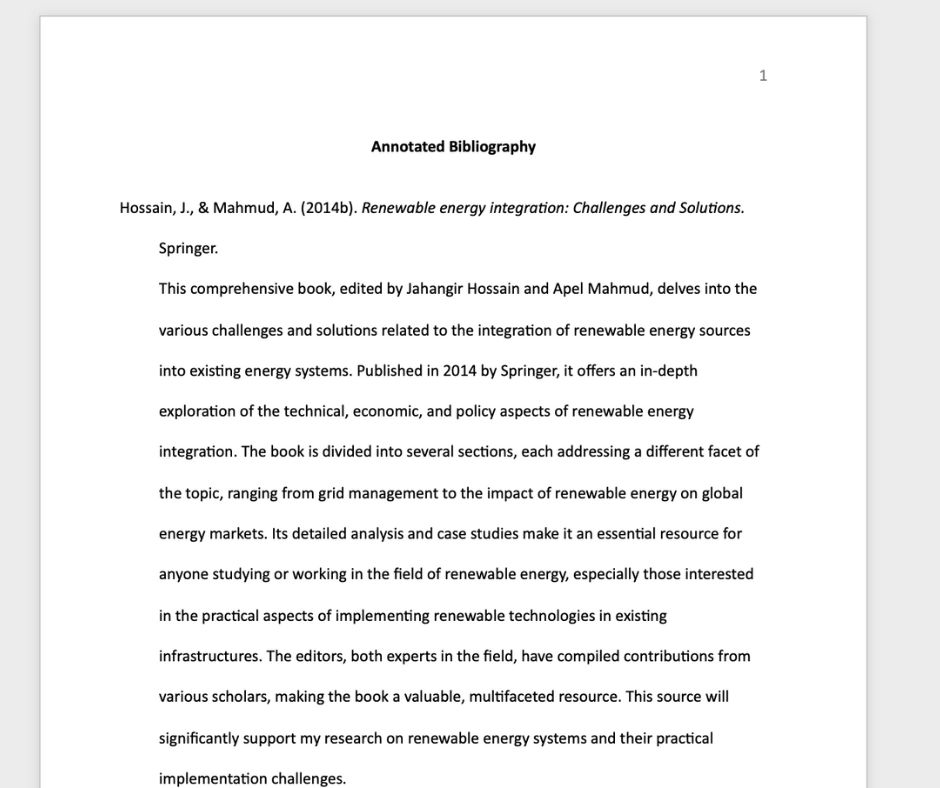APA Annotated Bibliography: Format and Examples
Many students face challenges in understanding and applying the APA format for annotated bibliographies; our guide aims to simplify this complex process with clear format instructions, illustrative examples, practical tips, and detailed guidelines to enhance your academic writing.
APA annotated bibliography
An APA annotated bibliography is a specialized document that combines the standard APA format for citations with a concise annotation for each cited source. In the context of the American Psychological Association (APA) style, which is commonly used in the social sciences, this type of bibliography includes two primary elements for each source: the citation and the annotation.
1. Citation: This is the reference for the source, formatted according to APA guidelines. It typically includes the author’s name, publication date, title of the work, and other relevant publishing details.
2. Annotation: Following each citation, the annotated bibliography includes a short paragraph, usually around 150-200 words, that describes and evaluates the source. This annotation aims to inform the reader about the relevance, accuracy, and quality of the sources cited. It may provide a summary of the content, an assessment of its value or relevance to the topic at hand, and comments on the author's background or authority in the subject area.
Overall, an APA annotated bibliography serves as a comprehensive review and analysis of the literature available on a specific topic, offering a snapshot of what has been published and providing insights into the depth and nature of the research. This makes it an invaluable tool for researchers, students, and academics who are conducting in-depth studies in their respective fields.
Creating an APA annotated bibliography demands a range of intellectual skills, including the ability to write succinctly and coherently, conduct a brief analysis, and perform thorough research on information sources. Depending on your research objectives and your instructor's guidelines, an annotated bibliography might be a component of a larger research project or an independent paper. An essential aspect of this task is understanding how to accurately cite sources.
Types of Annotated Bibliographies: Descriptive and Analytical Approaches
Annotated bibliographies, essential tools in academic research, come primarily in two distinct types: Descriptive (or Informative) and Analytical (or Critical). Understanding the differences between these types is crucial for students as they cater to varying research needs and academic objectives.
- Descriptive or Informative: This type focuses on providing a summary of the source's content. It includes details about the author, main arguments, evidence presented, and the conclusions drawn. The descriptive bibliography aims to inform the reader about the scope and main focus of the source without offering personal opinion or critical evaluation. It's particularly useful for providing an overview of a source's material without delving into its analytical aspects.
- Analytical or Critical: In contrast, an analytical bibliography goes beyond merely describing the content of the source. It provides a detailed analysis, critically examining the strengths and weaknesses of the arguments presented. This type involves evaluating the author's methodology, the research's validity, and its contribution to the field. It also reflects on the source's bias, reliability, and relevance to the research topic. The critical bibliography is instrumental for researchers who need to scrutinize and interpret the literature deeply.
Each type of annotated bibliography serves a specific purpose: while descriptive bibliographies are excellent for summarizing sources, analytical bibliographies are indispensable for evaluating and interpreting scholarly work. One or both kinds may be necessary for students to successfully accomplish their research goals, depending on the academic assignment's specifications and the type of research being conducted.
Choosing the Right Sources: The Foundation of Your APA Annotated Bibliography
The first and most important thing that the success of your research paper (and the annotation itself) depends on is the quality and relevance. Select your sources very thoroughly and attentively because they not only have to be in the area of your research and enlighten important issues but also be of high quality.
Therefore, at first, you need to determine the scope of your research very carefully to state the value of each source and decide whether include it in your annotated bibliography or not. Remember that it is going to make your research project reasonable. In order to make a good choice, try to follow the next steps and answer the following questions:
What is the issue of your investigation? What are the questions that you need to answer?
If the annotated bibliography is a stage of your research project, then it needs to follow the main research question. On the other hand, if your APA annotated bibliography is an independent and separate research project, then it is going to have it's topic and problem. In this case, define the list of questions you will answer in your annotation in such a way that it could be coherent and clear.
What sort of material is necessary for your research?
You may use scientific articles in journals and newspapers, books, websites, reports and interviews, and so on. Determine the scientific area of your research project very precisely. Remember that your annotation is not going to be broad. It should be narrow enough with deep content at the same time.
Make a summary of the argument of every source that you use. One of the purposes of your annotation is to restate the key argument of the information source. Pay attention that academic source annotation usually determines the research question of the source (as well as thesis or hypothesis, depending on the kind of source), the research's methodology, and, finally, the conclusions made by the author.
What is the strategy of writing the APA annotated bibliography?
When looking at an annotated bibliography sample, you see only the final result. However, you cannot see any efforts made by the author of the bibliography, and you cannot see there any strategies. At the same time, be sure that writing all kinds of research papers has a strategy. Below, take a look at some steps you should take.
- Determine the main thesis of the work (or the key research question, etc.). If you want to know what the research is all about, the best place to start is with the introduction and the conclusion.
- Pay attention to what terms are repeated in work. There also can be ideas that are mentioned many times. These are the main takeaways from the study, and when finding them, be sure that together with these key points, the author writes about the main research question and the purpose.
- Pay attention to the structure and organization of the text. It is probably divided into different parts, each of which enlightens the main question from various sides and viewpoints. Notice what ideas the emphasis is put on in the text. This strategy will be helpful when making up arguments for your annotated bibliography.
- Find out how the author uses the theory of his research. Does the theory provide evidence of the giving data? In addition, notice what methodology is used to prove the theory.
- Each paragraph of the research work probably has an opening sentence. In fact, there are always opening sentences in paragraphs. Therefore, pay attention to them. The point is that they usually provide a brief overview of the paragraph's remaining content as well as the paragraph's main idea.
- Read each paragraph that summarizes the research's key arguments. The annotated bibliography example doesn't demonstrate how the comprehension of the arguments was achieved. However, it gives a strong argumentation of each information source cited in the turabian paper.
Mastering APA Style in Annotated Bibliographies: Essential Guidelines and Formatting Rules
The APA style, widely used in the social sciences, has specific guidelines for formatting annotated bibliographies. Understanding these specifics is crucial for students and researchers to ensure their work aligns with the expected academic standards. Here are the key elements of APA style for annotated bibliographies:
- General Format: APA style annotated bibliographies should be double-spaced and use a standard 12-point font, such as Times New Roman. Margins should be set to 1 inch on all sides.
- Citation Format: Each entry begins with a full citation in APA format. This includes the author's last name, first initial, publication year, title, and publication details. For journal articles, include the volume and issue number, and for books, include the publisher's name.
- Hanging Indents: APA style requires using hanging indents for citations. This means the first line of the citation starts at the left margin, and subsequent lines are indented by 0.5 inches.
- Annotation Placement: The annotation appears directly after the citation, not on a separate page. There is no extra space between the citation and the annotation.
- Annotation Content: In APA style, annotations should be concise and typically range from about 150 to 200 words. The content should include a summary of the source, an evaluation of its credibility, and a reflection on its relevance to your research topic.
- Title Page and Running Head: If the bibliography is part of a larger APA style paper, it should include a title page and a running head as per APA guidelines.
- No Extra Line Between Citations: Unlike some formatting styles that require a space between entries, APA style does not. Do not add an extra line between the citations in your annotated bibliography.
- Margins: Set margins to 1 inch on all sides of the page. This uniform margin size is a standard requirement in APA formatting.
- Font and Size: Employ a clear, readable font. APA style typically recommends using a 12-point Times New Roman font.
- Alphabetical Order: Entries should be listed in alphabetical order based on the author's last name.
- Tone and Voice: The writing in the annotations should be formal and academic. It's important to maintain an objective tone and avoid personal language.
By adhering to these APA style specifics, students and researchers can create a well-organized and professionally formatted annotated bibliography that effectively supports their academic work.

You will probably find the evidence of the information mentioned above in an annotated bibliography sample. Also, you can use our assistance with writing your APA annotated bibliography. Moreover, we would like to inform you about other services we provide.
- Writing the best dissertation.
- Helping with thesis synonym.
- Assistance with CSE paper format.
- Giving a 1000 word essay example.
- Writing criminology papers.
- Dissertation editing services.
New Here? Get $5 OFF
Your First Project
We are a team of enthusiastic professionals and geeks in our field.
At the very start of the project
Money-Back Guarantee
Support 24/7
No Hidden Charges
Who Are the Experts?
Our experts are alumni from the world’s top universities and colleges.
All of them have successfully passed the Studybay examination and proven their competence to our team.
Our experts have graduated from the best universities in the world







Already Got Help? Write Your Review
👏